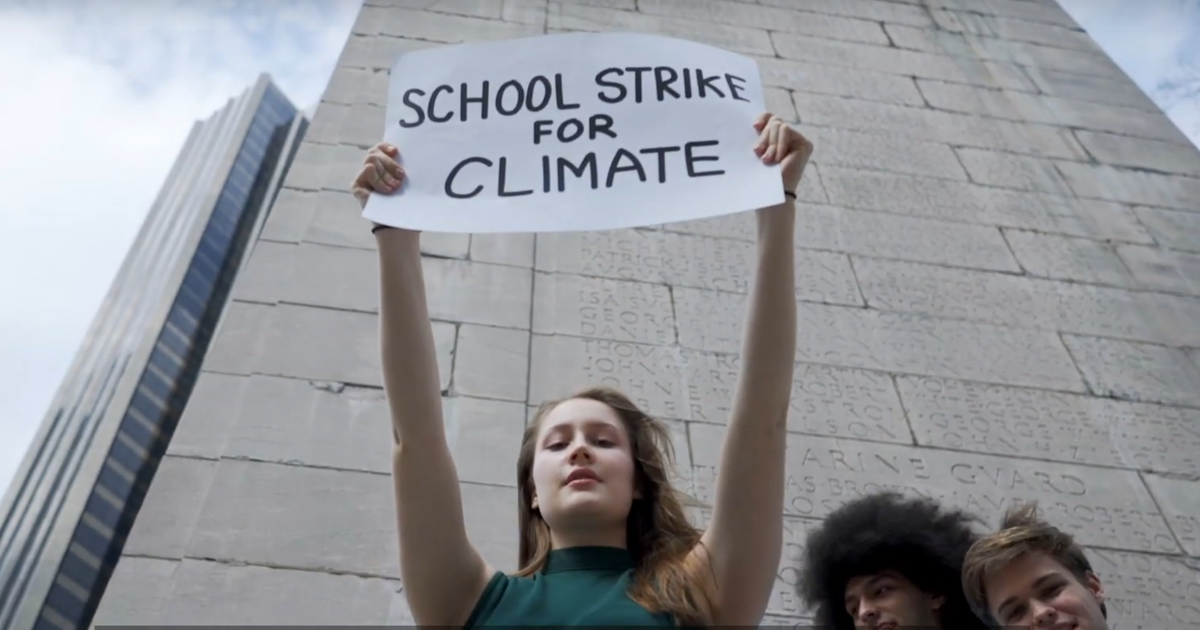This is the fourth in a series of commentaries on the Future of Climate Strikes. It describes how the determined action of one young woman – and the determination of millions of other youth to act on climate — led within a year to a Global Strike for Climate with more than seven million participants. For the entire Future of Climate Strikes series see here.

Early in 2018, a 15-year-old Swedish girl named Greta Thunberg (pictured above) decided to start a student strike for climate. She said she was inspired by the students in Parkland, Florida who had “refused to go to school after the school shootings” until gun-control legislation was passed. She painted a sign on a piece of wood and, for the flyers, wrote down some facts she thought everyone should know. On August 20, 2018 she took her bike to the Swedish Parliament and “just sat there.” The first day “I sat alone from about 8:30am to 3pm – the regular school day.” Then she posted what she was doing on Twitter and Instagram and it went viral. “On the second day, people started joining me. After that, there were people there all the time.”[1]
Word of Greta’s strike spread by news channels and social media, and soon others were joining the Friday walkouts around the world. She rapidly became an international celebrity. In December 2018, Greta gave a speech to international climate negotiators meeting in Poland. “You say you love your children above all else, and yet you are stealing their future in front of their very eyes.”[2]
A 13-year-old New Yorker named Alexandria Villaseñor saw the speech on television, looked up Greta online, and decided to join her climate strike. “I am too young to vote and to lobby, but I can sit down with a sign and make my voice heard.” On December 14 Alexandria took a sign reading “SCHOOLSTRIKE4CLIMATE” and sat down in front of the United Nations Headquarters. For the next eight weeks she repeated her action without being joined by a single other person.[3] But she connected virtually with other students around the country and formed Youth Climate Strike US.[4]
Twelve-year-old Haven Coleman in Denver Colorado read Alexandria’s tweets and Instagram posts and decided to start her own Friday strikes outside the capitol building in Denver. She also recruited 16-year old Isra Hirsi in Minneapolis, who had marched for several years with the youth climate group iMatter and had coordinated a local protest against gun violence. These three formed a team to initiate a national student climate strike. According to Isra, “It wasn’t our parents, it wasn’t any adults: this whole thing is all run by middle school, high school, and college students.” We’re doing this “all by ourselves—it’s literally just us, working really hard, because we understand the impacts of climate change and we really have to do something about it.”[5]
The team communicated constantly via text messages, Instagram, email, and video conferences – they had to persuade their school principals to let them check their phones during lunch. Haven Coleman said, “Organizing a national strike is a lot like organizing a local rally/march, but op-eds, lots of op-eds and way more texts, email, decisions + zoom calls than I ever imagined humanly possible. If this is being an adult I’m not ok with growing up!” Students volunteered to organize strikes in almost every state. They drew up demands for a Green New Deal, science-based government climate policy, and education about climate change in every grade of elementary school.[6] Organizations like the Sierra Club and 350.org offered support while recognizing the leading role of the students.[7]
By early 2019 thousands of students in Australia, the UK, Belgium, the US, Japan, and elsewhere were joining the weekly strikes. In Switzerland, more than 20,000 school and college students in 15 cities turned out.[8] When Belgium’s environment minister called the strikes a “setup” she was forced to resign, and 20,000 young people poured into the streets of Brussels the next day. Fifteen thousand joined the strike in Australia.[9]
The students, using social media to coordinate around the world, set March 15 2019 as a global day of action. In the US, two weeks before the strike there were 110 people on the planning call. One student asked, “What should I do if I can’t make it to a strike?” “Bang on a pot in class,” Haven answered, and “make sure to tell people why you’re doing it.”[10]

Climate change affects everyone. Whether you’re a young person concerned about the future of our planet or a union worker nervous about the state of your industry, climate issues matter. Again for Earth Day 2020, Labor Network for Sustainability (LNS) and 350.org partner up to share how people in the labor movement and young people feel about about climate justice and youth action in the climate emergency. Watch the video >>
Strikes were planned in 100 locations in the US. In Port Angeles WA on March 15, high school students walked out of their classes and took up signs and banners about climate change.[11] In Washington, DC the lawn in front of the United States Capitol was crowded with hundreds of protestors chanting “No action, no future!”[12] In Asheville, NC, five high school students addressed a rally of 200.[13]
From Australia and New Zealand to Asia, Europe, Africa, North America, and South America, on March 15 students joined the strike.[14] Greta Thunberg tweeted, “We have already passed way over one million students on school strike today. Over 2,000 places in 125 countries on all continents. And we have only just started.”[15] The ultimate tally was 1.4 million participants in 2,233 cities and towns in 128 countries worldwide.[16]
The student climate strikes grew out of a common response to a shared problem. Millions of young people felt the threat of climate change, yet saw those in authority in the adult world abdicating their responsibility to reverse it. The strikes spread by imitation and self-organization. They went from a single individual to seven million in less than a year because young people felt the need, organized themselves, and reached out to each other and to adults.
The student strikes had an impact in part because they violated rules and expectations. Students interrupted and disrupted their schools and withdrew from their normal life activities. Students had to overcome opposition, ridicule, and in some cases disciplinary reprisal. Their actions focused the attention of the world on the problem of climate change and the failure to address it. Their message educated millions about how people can fight climate change. It encouraged others to act both by providing an inspiring example and by shaming those who had the responsibility to act but failed to do so.
Of course, strikes by students did not have the direct impact on those in authority, or on the economy as a whole, that a strike by workers would. But their impact would nonetheless be seen in September 2019, when millions of adults joined the climate strikes. That posed the question: How could the climate strikes move beyond students and individual adults to mobilize the full power of the world’s people to force an end to climate destruction?
[1] Jonathan Watts, “Greta Thunberg, schoolgirl climate change warrior,” The Guardian, March 11, 2019, https://www.theguardian.com/world/2019/mar/11/greta-thunberg-schoolgirl-climate-change-warrior-some-people-can-let-things-go-i-cant.
[2] “You Are Stealing Our Future: Greta Thunberg, 15, Condemns the World’s Inaction on Climate Change,” Democracy Now, December 13, 2018, https://www.democracynow.org/2018/12/13/you_are_stealing_our_future_greta
[3] Sarah Kaplan, “How a 7th-grader’s strike against climate change exploded into a movement,” Washington Post https://www.washingtonpost.com/national/how-a-7th-graders-strike-against-climate-change-exploded-into-a-movement/2019/02/15/e20868e2-2fb4-11e9-86ab-5d02109aeb01_story.html.
[4] https://www.youthclimatestrikeus.org See also Alejandra Boruda, “These young activists are striking to save their planet from climate change, National Geographic, March 13, 2019 https://www.nationalgeographic.com/environment/2019/03/youth-climate-strike-kids-save-the-world/.
[5] Boruda.
[6] Boruda.
[7] Boruda.
[8] “Swiss youths strike for climate protection,” SWI, January 18, 2019. https://www.swissinfo.ch/eng/multimedia/environmental-protest_swiss-youths-strike-for-climate-protection-/44687898
[9] Kaplan.
[10] Boruda.
[11] Port Angeles students take part in climate protest,” Peninsula Daily News, March 17, 2019. http://www.peninsuladailynews.com/news/port-angeles-students-take-part-in-climate-protest/
[12] Shreeya Agarwal, “’No action, no future,’” The Diamondback, March 17, 2019. http://www.dbknews.com/2019/03/18/umd-worldwide-climate-change-protest-strike-washington-dc/
[13] Daniel Walton, “Students join in global Youth Climate Strike,” MountainXpress, March 18, 2019. https://mountainx.com/news/asheville-students-join-in-global-youth-climate-strike/
[14] “Climate strikes held around the world – as it happened,” The Guardian, March 15, 2019.
[15] Greta Thunberg (@GretaThunberg), quoted in “Climate strikes held around the world – as it happened.”
[16] “School Climate Strikes: 1.4 million people took part, organizers say,” The Guardian, March 19, 2019. https://www.theguardian.com/environment/2019/mar/19/school-climate-strikes-more-than-1-million-took-part-say-campaigners-greta-thunberg

